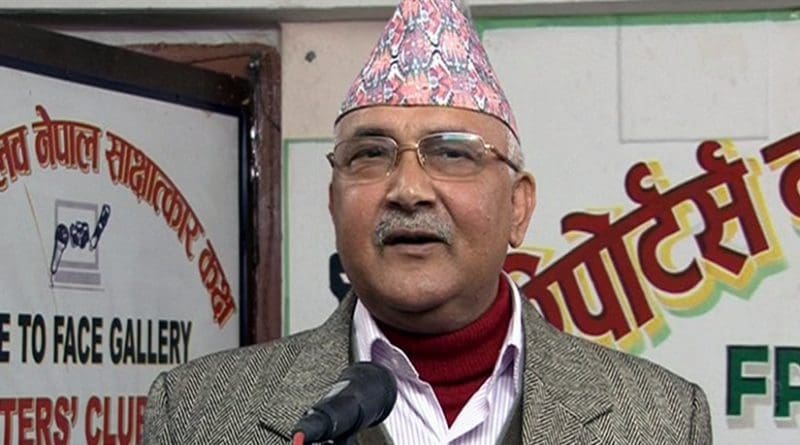Significance Of Nepal Prime Minister KP Oli’s New Delhi Visit – Analysis
By IPCS
By Pramod Jaiswal*
The Prime Minister of Nepal, KP Sharma Oli, will his maiden visit to India, from 19 February 2016. During his six-day visit, he is scheduled to meet Indian President Pranab Mukherjee, Indian Vice President Hamid Ansari, Indian Prime Minister Narendra Modi, and Indian Minister of External Affairs Sushma Swaraj, among others. He is also scheduled to visit Mumbai, Dehradun and Bhuj. Oli’s visit comes at a time when India-Nepal relations are under strain with Kathmandu accusing New Delhi of having a hand in the ‘undeclared blockade’ at the border. Therefore, given the prevailing state-of-affairs, it will be useful to explore the ongoing developments in the bilateral and the significance of this visit.
India-Nepal Relations
India and Nepal have historical, socio-cultural and economic ties. The border between the two countries are open, post the 1950 Indo-Nepal Treaty of Peace and Friendship, both countries provide special privileges to each other. Cross-border marriages are also quite common. India is Nepal’s largest trading partner and has contributed significantly towards development of the nation. It has played a critical role in all the political transformation in Nepal. Most recently, in the aftermath of the massive earthquake that struck Nepal in April 2015, India was the first country to provide a team of the National Disaster Response Force, along with relief material, and even pledged USD 1 billion for Nepal’s reconstruction.
In spite of its remarkable contributions in the country, New Delhi has been strongly criticised.
The recent controversy emerged with the mention of the Lipu-Lekh Pass in the joint statement issued during the Indian prime minister’s visit to China in May 2015. Nepal stated that the mention of the Lipu-Lekh Pass in their joint statement threatened Nepal’s sovereignty and territorial integrity.
Furthermore, there has been major setback in bilateral relations since the promulgation of Nepal’s new constitution and the election of the incumbent Prime Minister KP Sharma Oli. The Oli government accused India for imposing the blockade that led to a severe humanitarian crisis in Nepal. India refuted those allegations, stressing that the border tensions were caused by the Madhesi parties and were the outcome of internal protests in Nepal, and that Kathmandu should urgently resolve the issue to create a sense of “security and harmony” in the Terai region and ensure “uninterrupted commerce.”
The current deadlock in Nepal erupted with the promulgation of the ‘non-inclusive’ constitution that ignored the demands of the Madhesis, the Tharus, other indigenous groups, and women, leading to the strong protests in the southern plains. This resulted in a disruption at the India-Nepal border.
Nepalese leaders had repeatedly assured India of an ‘inclusive’ constitution. A last-minute attempt too was made in the form of sending its most capable officer as the prime minister’s envoy, but it was in vain. It was the first time that India openly stood by the voices of the Madhesis and the Tharus, and there were two basic reasons for the same: first, India was witness to the 2008 agreement between the government and the Madhesi party and second, an ‘inclusive’ constitution would bring peace and stability in Nepal that will serve India’s security concerns.
Interestingly, on 05 February 2016, in a mysterious turn of events, protestors were driven away from the India-Nepal border, allowing for the movement of vehicles. 135 days after the protest began, the Madhesi parties that had led the protest were forced to announce the end of blockade.
Significance of Prime Minister Oli’s Visit
Oli’s visit was actualised due to slight progress on both the fronts, and is a clear indication of a change in India’s approach (from hard-handedness to soft) towards Nepal. It is also New Delhi’s last ditch effort to convince Oli and resolve the ongoing crisis in Nepal. Moreover, it bears great significance not just because it is scheduled to take place at such a critical juncture but also because it will have lasting implications on the India-Nepal bilateral.
Since the focus during this visit will be on the resolution of the current crisis, signing of agreements is unlikely. The Oli government had already visited New Delhi with the commitment to resolve the crisis through the ‘roadmap’ – that mentioned resolving the issue via amendments and a political mechanism with a three-month timeframe.
Oli’s visit is aimed at building confidence between the two governments. India expects delivery on commitments within the stipulated time. In return, Oli seeks India support for his regime. The Oli government lives with the fear of being overthrown, with Indian political maneuvering, after his government addresses the demands of the Madhesis, particularly due to his leaning towards China.
The visit has surely generated environment for normalisation in the relations. By sending a high-level political delegation under the leadership of the Indian Minister of External Affairs Sushma Swaraj to pay a final homage to Nepal’s former Prime Minister Sushil Koirala when he passed, New Delhi indicated its commitment to engage with the Oli government. The Delegation called on the Nepalese president and prime minister before returning.
The present halt in the Madhes movement is only temporary, as anger still remains among the Madhesis remains. It is yet to be seen if India is able to win Oli over and get both sides (Kathmandu and the Madhesis) together for peace and stability in the country. The next three months will be crucial for Oli and much of India’s relations with Nepal depend on it.
*Pramod Jaiswal
Senior Research Officer, IReS, IPCS
E-mail: [email protected]

